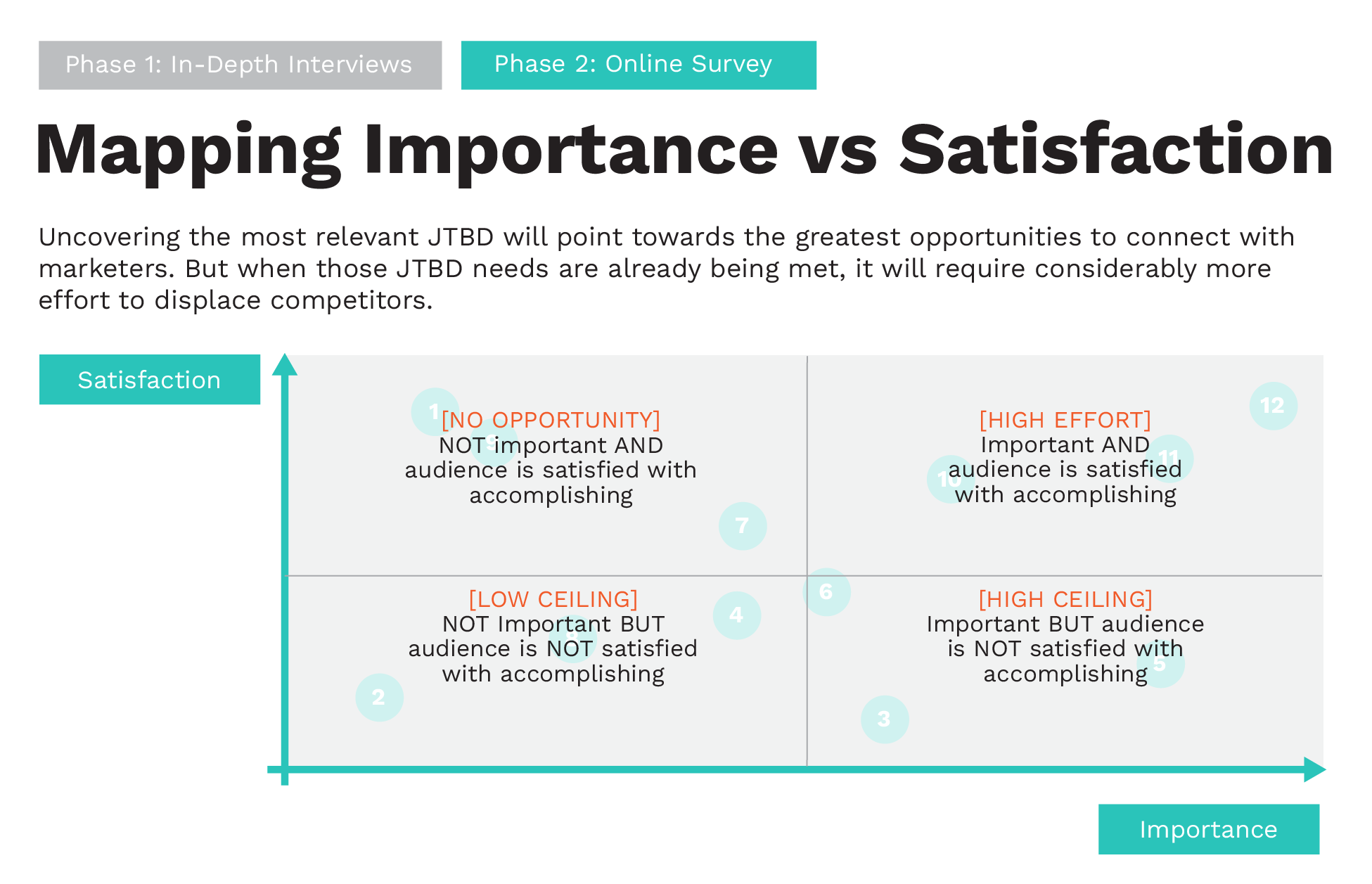Research and Product Development: Unlocking Buyers Needs with Jobs To Be Done
It’s no mystery that the key to successful product development and marketing initiatives starts with understanding your customers' needs. But what if those needs aren't what they seem at first glance? Gamers are a unique target with seemingly direct and specific needs. But through our Jobs To Be Done Research, we learned there’s more to a laptop than RAM.
Gamers Want More Than Specs
Gamers are a tough crowd to please, and for good reason. Brands have been throwing specs like RAM, GPUs, and cooling systems at them for years, yet some gaming laptops still collect dust on the shelves. Why? Because these brands are missing the bigger picture. Enter the Jobs to Be Done (JTBD) approach, where we ask the critical question: What job are gamers really hiring a laptop to do?
It turns out it’s not just about raw performance or flashy RGB lights. When we talked to the gamers themselves, we found out they weren’t just comparing gaming laptops to other laptops. Nope, they were weighing them against some pretty unexpected competition:
![]()
Desktop PCs – Sure, these beasts pack more power, but good luck hauling them to your next tournament or friend’s LAN party.
![]() Consoles – More budget-friendly, but also one-trick ponies—great for gaming, not so great for handling schoolwork, streaming, or content creation. Fun fact: Console sales are expected to hit $66 billion by 2027, but gamers are still looking for versatility beyond just gaming.
Consoles – More budget-friendly, but also one-trick ponies—great for gaming, not so great for handling schoolwork, streaming, or content creation. Fun fact: Console sales are expected to hit $66 billion by 2027, but gamers are still looking for versatility beyond just gaming.
![]()
Phones or Tablets – Super portable, but they can’t deliver that fully immersive experience serious gamers crave.
So, what *job* is a gaming laptop really doing for them? It’s about more than just gaming.
One gamer told us, “When I’m on the road, I need my laptop to be powerful enough to handle my games but lightweight enough that I’m not lugging around a brick.” That’s the job: portability with power. The desired outcome? A laptop that lets them game anywhere without sacrificing performance. This resonates with why gaming laptops, a market expected to reach nearly $17 billion by 2025, are gaining popularity—they offer the power of a gaming rig without the anchor of a desktop.
Another gamer said, “I want my laptop to handle everything from streaming to video editing without breaking a sweat.” That’s a different job: versatility in a powerhouse. The outcome? A machine that can seamlessly switch from running high-end games to churning out content. As gaming continues to intertwine with streaming and content creation, gamers are looking for devices that can keep up with both. After all, Twitch had over 7.4 million active streamers in 2023 —and many of them need laptops that are as versatile as they are powerful.
These are functional jobs, but gamers have social and emotional jobs, too. By understanding the *real* jobs gamers are hiring their laptops to do, brands can create experiences that go beyond the specs, giving gamers what they’re really looking for.
What is Jobs To Be Done?
Customers do not want products; instead, they “hire” products to perform jobs they need to do. As Theodore Levitt famously said, "People do not want a quarter-inch drill; they want a quarter-inch hole." This principle is at the heart of the JTBD theory. JTBD’s robust framework identifies six avenues through which customers may "hire and fire" products. By understanding these pathways, we can better align your offerings with your customers' actual needs.
JTBD’s robust framework identifies six avenues through which customers may "hire and fire" products. By understanding these pathways, we can better align your offerings with your customers' actual needs.
The Illuminas Approach
At Illuminas, we primarily follow the Outcome-Driven Innovation (ODI) framework that Tony Ulwick and Strategyn developed. This approach focuses on identifying:
- Core functional jobs
- Related jobs
- Emotional/Social jobs
- Consumption chain jobs
Using this framework, we can explain the underlying needs and desired outcomes that motivate buyers. Identifying needs, particularly underserved ones, facilitates product development, messaging, positioning strategies, and identifying high-opportunity market segments.
Our framework includes the following steps:
1. Identifying Jobs
We start by clearly defining the job to be done, whether it is a core functional, related, emotional/social, or consumption chain job.
In the gaming scenario, the jobs were portable performance and versatility. But that’s not all.
Gaming is often a source of emotional satisfaction for players, and the gaming laptop is the gateway to that experience. For many gamers, a laptop isn’t just a device; it’s a portal into virtual worlds where they can escape daily life. They are hiring a laptop to give them uninterrupted access to immersive experiences that take them away from the stresses of reality.
2. Understand the Customer’s Context
Once you know the job, you must understand the customer's context. This includes understanding their needs, wants, and motivations. We do this by exploring desired outcomes.
We ask how the user will measure success. At Illuminas, our desired outcome statements include:
- Direction of improvement
- A predictive metric (usually time or likelihood)
- An object of control
- A contextual clarifier (optional)
We could state the desired outcome for the emotional job gamers seek from gaming laptops: “Increase my sense of immersion in the gaming environment by enhancing the graphics, sound quality, and speed of transitions to keep me engaged in the gaming world.”
3. Identify the Customer’s current solution
We then determine buyers' current solutions, asking, “What have you hired to get this job done in the past?” Gamers may have relied upon non-gaming PCs, desktop PCs, consoles, and smartphones.
4. Identify the customer’s pain points
Once you know the customer's current solution, you must identify their pain points. This includes understanding what they don't like about their current solution and what they would like to see improved.
5. Job Statement
When we gather all of these insights into the current jobs to be done, we can create a job statement.
A well-defined job statement follows the format:
When I [situation/context], I want to [need] so that I can [desired outcome] without [pain points].
Gaming is inherently social, whether through online multiplayer games or participation in gaming communities. A gaming laptop can be hired to fulfill key social jobs. A gaming laptop's brand, design, and specs can signal to other gamers that the user is serious about gaming. A sleek, powerful laptop becomes a badge of honor, demonstrating a gamer’s desired self-identity.
These insights empower companies to create products and strategies that connect with their target audience. The results of this process include innovations to existing solutions, more relevant messaging avenues, and expansions to product lines that address unmet needs and drive growth and customer loyalty.
Research Methods for Jobs To Be Done
We employ a mixed-mode approach, typically starting with qualitative market research followed by quantitative validation:
Qualitative Research: We conduct in-depth interviews (minimum of 5 per segment of interest) to discover core functional jobs, related jobs, and social and emotional jobs.Quantitative Research: We use surveys to determine the relative importance of each job and satisfaction with current solutions. This allows us to map overserved and underserved needs.

Analysis and Insights: We use tools like the JTBD Canvas to structure our data for further analysis. This helps us identify:
- Key obstacles customers face
- Criteria used to evaluate solutions
- Factors influencing purchase decisions
- Post-purchase experiences and pain points
Actionable Recommendations
Finally, we translate our findings into actionable recommendations for your business. These might include:- Product innovation opportunities
- Marketing and positioning strategies
- Customer experience improvements
- New market segment opportunities
Why JTBD Matters
JTBD is more than just a theory; it's a practical tool for driving business growth. This process focuses on customer needs and helps brands articulate benefits that resonate rather than just listing features. This research allows a deeper understanding of buyers' success criteria and usage barriers, allowing us to predict satisfaction levels, proactively address issues hindering customer acquisition and retention, and inform product development and marketing strategies.
When Do You Need JTBD in Research and Product
Development?
Let's look at how JTBD can be applied in real-world scenarios:
- Product Innovation: By understanding the job your customers are trying to get done, you can design products and services that more effectively meet their needs. This can lead to higher customer satisfaction and loyalty.
- Positioning and Communication: JTBD insights allow you to craft messaging that resonates with your customers' underlying motivations, making your marketing more impactful and cost-effective.
- Buyer Personas: Based on JTBD and motivations, we can create more accurate and useful buyer personas. This process keeps you focused on solving real customer problems, fostering a culture of customer-centric innovation within your organization.
- Switch Analysis: JTBD helps explore the likelihood of your target audience switching from existing solutions, given the relative value of benefits. It can help you identify unmet market needs that your competitors might be overlooking, giving you a competitive edge.
Ready to Uncover Your Customers' True Needs?
At Illuminas, we don't just apply JTBD theory – we elevate it. Our approach combines rigorous quantitative and qualitative research methods to deliver actionable insights. We understand you're not just looking for data; you need a clear, strategic direction to drive your business forward.
Our team of experts is adept at breaking down complex ideas into easy-to-understand messages, ensuring that the insights we deliver are comprehensive and readily applicable across your organization.
Understanding the jobs your customers need to get done can be the difference between market leadership and obsolescence. Let Illuminas guide you through the JTBD journey, uncovering insights to drive your next big innovation.




